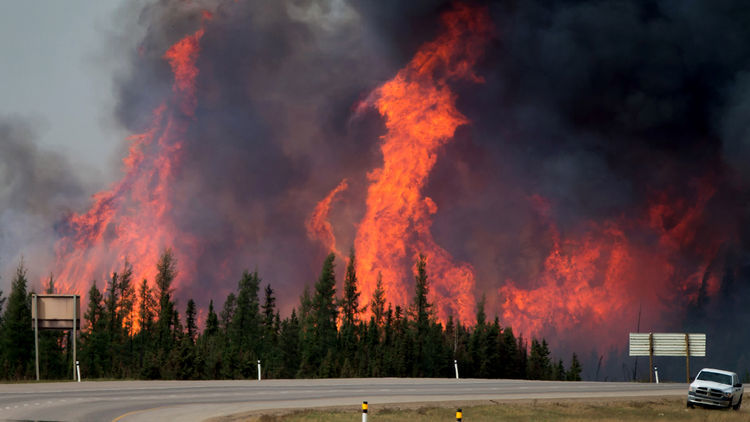
The massive wildfires that swept through Canada’s energy hub of Fort McMurray left about 85 percent of the city intact, including most of the downtown core, while completely leveling some neighborhoods.
“This city was surrounded by an ocean of fire just a few days ago,” Alberta Premier Rachel Notley told reporters after a media tour of Fort McMurray Monday “The city has been saved.”
About 88,000 residents were evacuated last week as the fire laid siege to the city, and oil-sands companies trimmed an estimated 1 million barrels a day of production, or about 40 percent of output. An evacuation order remains in place and the government hasn’t said when the residents can return. Companies that took production offline — including Suncor Energy Inc., Syncrude Canada Ltd. and ConocoPhillips — are already making plans to bring workers back and restart operations as the fire has moved away from their sites.
Notley said about 2,400 buildings were lost in the fire, while 25,000 were spared, including the airport, all schools, hospitals and water treatment facilities. The premier said she expects to have a plan to return residents to Fort McMurray over the next two weeks, cautioning that it remains a dangerous place. Some neighborhoods were completely destroyed by the wildfires, which began April 30.
“There are smoldering hot spots everywhere,” she said. “This city is going to be made safe.”
Cooler weather and favorable winds have eased the threat to Fort McMurray and to the oil-sands facilities that sit to the north and south of the city. Energy plants largely came out unscathed from the fires, except for minor damage at Cnooc Ltd.’s Long Lake site operated by its unit Nexen. Operators including Suncor and Syncrude said they properly managed shutdowns that will allow them to optimally resume operations, pending the restart of pipelines in the region.
Suncor, Canada’s biggest energy company, plans to begin flying workers back to its sites in the next couple of days and begin starting units by the end of the week, said two people familiar with operations, declining to be identified because the information isn’t public. Notley said she plans to meet with industry leaders Tuesday to discuss their start-up plans.
About 33 fires were still burning in the province as of Monday morning, including three that are out of control, Travis Fairweather, a forestry spokesman, said by phone. Cooler weather over the coming days is expected to ease conditions for firefighters.
“It should help our crews out there quite a bit after a couple of really hot, really dry days when they’ve had to really work out there,” he said. “Now we can try and dig in and make a little progress here.” There are more than 700 firefighters working in and around Fort McMurray to contain the fire, Fairweather said.
Prime Minister Justin Trudeau on Monday said he declined international offers of aid, such as firefighters or aircraft, saying Canada has all the equipment it needs as help arrives in Alberta from across the country. “Canada will be a partner in how we rebuild Fort McMurray, ” Trudeau told reporters Monday in Ottawa. He plans to announce a visit to the city soon, he said.
The influx led to another problem — a viral outbreak at Edmonton’s evacuee welcome center. About 40 to 50 cases of viral gastroenteritis were reported over the weekend in the center. “We’re seeing an increased number of cases of nausea and vomiting of people attending the reception center here,” Christopher Sikora, Alberta’s medical officer of health for the Edmonton region, told reporters Monday, urging diligent hand-washing.
West Texas Intermediate rose as much as 2.9 percent to $45.94 a barrel on the New York Mercantile Exchange on Monday. Prices fell $1.22 to close at $43.44 in New York.
The wildfires may lead to the great catastrophe ever in Canada, with insured losses of as much as C$7 billion, according to estimates Monday from National Bank of Canada. Intact Financial Corp., the country’s biggest insurer, may post insured losses of as much as C$1.1 billion ($850 million) from the wildfires, which could dent the Canadian economy harder than Hurricane Katrina hit the U.S., based on the relative sizes of the two economies.
Once the fires are under control, mines could be back to normal production levels in about a week, Morgan Stanley said in an e-mailed research note on Monday. In-situ projects, which use steam to extract the oil, could take two or more weeks depending on the start-up method and pressure requirements, it said.
Syncrude Canada, a joint venture controlled by Suncor, shut down its Aurora mine and Mildred Lake operation about 40 kilometers north of the city and has evacuated about 1,200 workers. Syncrude has a capacity of 350,000 barrels of oil a day. Smoke reached Syncrude’s Mildred Lake site Saturday, company spokesman Leithan Slade said in an e-mailed statement. “We will bring operations back online only when it is safe to do so.”
Suncor, Phillips 66 and Statoil ASA have declared force majeure — a provision protecting companies from liability for contracts that go unfulfilled for reasons beyond their control — on supplies from the region. Any restart will happen once it’s safe and when third-party pipelines are available, Suncor said.
Husky Energy Inc., controlled by Hong Kong billionaire Li Ka-Shing, said Sunday it has completely shut its Sunrise facility, which has a capacity of 60,000 barrels a day and was producing about half that before the blaze began. Nexen’s operation, with a capacity of 92,000 barrels a day, was shut. The company didn’t return requests for comment.